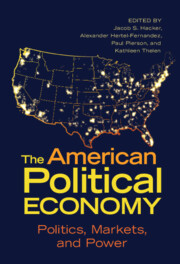99 results
In Memoriam: Frances McCall Rosenbluth
-
- Journal:
- Political Science Today / Volume 2 / Issue 1 / February 2022
- Published online by Cambridge University Press:
- 01 March 2022, pp. 21-22
- Print publication:
- February 2022
-
- Article
-
- You have access
- HTML
- Export citation
Introduction - The American Political Economy: A Framework and Agenda for Research
-
-
- Book:
- The American Political Economy
- Published online:
- 29 October 2021
- Print publication:
- 11 November 2021, pp 1-48
-
- Chapter
- Export citation
2 - The Role of the Law in the American Political Economy
- from I - Political Arenas and Actors
-
-
- Book:
- The American Political Economy
- Published online:
- 29 October 2021
- Print publication:
- 11 November 2021, pp 76-102
-
- Chapter
- Export citation
Bibliography
-
- Book:
- The American Political Economy
- Published online:
- 29 October 2021
- Print publication:
- 11 November 2021, pp 419-472
-
- Chapter
- Export citation
III - Corporate Power and Concentration
-
- Book:
- The American Political Economy
- Published online:
- 29 October 2021
- Print publication:
- 11 November 2021, pp 245-320
-
- Chapter
- Export citation
IV - The American Knowledge Economy
-
- Book:
- The American Political Economy
- Published online:
- 29 October 2021
- Print publication:
- 11 November 2021, pp 321-418
-
- Chapter
- Export citation
II - Race, Space, and Governance
-
- Book:
- The American Political Economy
- Published online:
- 29 October 2021
- Print publication:
- 11 November 2021, pp 131-244
-
- Chapter
- Export citation
Tables
-
- Book:
- The American Political Economy
- Published online:
- 29 October 2021
- Print publication:
- 11 November 2021, pp x-xi
-
- Chapter
- Export citation
Acknowledgments
-
- Book:
- The American Political Economy
- Published online:
- 29 October 2021
- Print publication:
- 11 November 2021, pp xiii-xiv
-
- Chapter
- Export citation
Epilogue - The American Political Economy Confronts COVID-19
- from IV - The American Knowledge Economy
-
-
- Book:
- The American Political Economy
- Published online:
- 29 October 2021
- Print publication:
- 11 November 2021, pp 407-418
-
- Chapter
- Export citation
Contributors
-
- Book:
- The American Political Economy
- Published online:
- 29 October 2021
- Print publication:
- 11 November 2021, pp xii-xii
-
- Chapter
- Export citation
I - Political Arenas and Actors
-
- Book:
- The American Political Economy
- Published online:
- 29 October 2021
- Print publication:
- 11 November 2021, pp 49-130
-
- Chapter
- Export citation
Copyright page
-
- Book:
- The American Political Economy
- Published online:
- 29 October 2021
- Print publication:
- 11 November 2021, pp iv-iv
-
- Chapter
- Export citation
Figures
-
- Book:
- The American Political Economy
- Published online:
- 29 October 2021
- Print publication:
- 11 November 2021, pp vii-ix
-
- Chapter
- Export citation
Contents
-
- Book:
- The American Political Economy
- Published online:
- 29 October 2021
- Print publication:
- 11 November 2021, pp v-vi
-
- Chapter
- Export citation

The American Political Economy
- Politics, Markets, and Power
-
- Published online:
- 29 October 2021
- Print publication:
- 11 November 2021
12 - The Anxiety of Precarity
- from Part III - Politics
-
-
- Book:
- Who Gets What?
- Published online:
- 20 August 2021
- Print publication:
- 29 July 2021, pp 281-306
-
- Chapter
- Export citation
Institutional Sources of Business Power
-
- Journal:
- World Politics / Volume 72 / Issue 3 / July 2020
- Published online by Cambridge University Press:
- 06 July 2020, pp. 448-480
- Print publication:
- July 2020
-
- Article
- Export citation
The American Precariat: U.S. Capitalism in Comparative Perspective
-
- Journal:
- Perspectives on Politics / Volume 17 / Issue 1 / March 2019
- Published online by Cambridge University Press:
- 16 January 2019, pp. 5-27
- Print publication:
- March 2019
-
- Article
-
- You have access
- HTML
- Export citation
Regulating Uber: The Politics of the Platform Economy in Europe and the United States
-
- Journal:
- Perspectives on Politics / Volume 16 / Issue 4 / December 2018
- Published online by Cambridge University Press:
- 23 November 2018, pp. 938-953
- Print publication:
- December 2018
-
- Article
- Export citation

